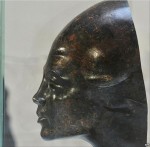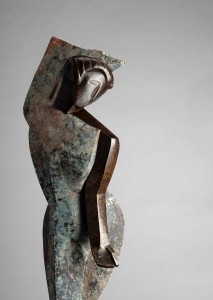 Eleven sculptures derided by the Nazi Party as degenerate art have been found in a bombed out cellar in front of City Hall in Berlin. Workers uncovered the sculptures over the course of several months while digging to build a new subway stop. Unlike many other European capitals, Berlin was something of a sleepy town for most of its history, and what with the extensive bombing during World War II, subway excavations don’t usually turn up much in the way of historical gems.
Eleven sculptures derided by the Nazi Party as degenerate art have been found in a bombed out cellar in front of City Hall in Berlin. Workers uncovered the sculptures over the course of several months while digging to build a new subway stop. Unlike many other European capitals, Berlin was something of a sleepy town for most of its history, and what with the extensive bombing during World War II, subway excavations don’t usually turn up much in the way of historical gems.
 The street where these sculptures were found, Königstrasse, was a busy, bustling thoroughfare before the war which was so intensely bombed in 1944 that there was basically nothing left but the skeleton frames and foundations of a few buildings. They were bulldozed and the rubble buried, so the only thing remaining to be found today are the cellars of buildings, hence the almost miraculous survival of the sculptures.
The street where these sculptures were found, Königstrasse, was a busy, bustling thoroughfare before the war which was so intensely bombed in 1944 that there was basically nothing left but the skeleton frames and foundations of a few buildings. They were bulldozed and the rubble buried, so the only thing remaining to be found today are the cellars of buildings, hence the almost miraculous survival of the sculptures.
 Even before the bombing art the Nazis considered degenerate — anything modern, basically, from Picasso to Jazz — was destroyed en masse. Whatever pieces Nazi Party officials didn’t steal for their own collections or sell to fund the war effort, they liked to burn in public bonfires. Some 20,000 art works were classified as degenerate. In 1937 there was a traveling exhibit of degenerate art intended to drum up public disdain for modern styles. Pieces were hung willy-nilly in poorly lit rooms with mocking graffiti all over the walls.
Even before the bombing art the Nazis considered degenerate — anything modern, basically, from Picasso to Jazz — was destroyed en masse. Whatever pieces Nazi Party officials didn’t steal for their own collections or sell to fund the war effort, they liked to burn in public bonfires. Some 20,000 art works were classified as degenerate. In 1937 there was a traveling exhibit of degenerate art intended to drum up public disdain for modern styles. Pieces were hung willy-nilly in poorly lit rooms with mocking graffiti all over the walls.
Many of the works now discovered in Berlin were part of that travelling show. Historians working on identifying the provenance of the pieces now unearthed have found documents indicating that some of them were returned to the Nazi Propaganda Ministry in 1941. After that, though, the paper trail goes cold.
Wemhoff believes that the works may have been purchased by a resident of Königstrasse 50, beneath which the finds were made, to save them from destruction. Initial speculation has centered around Erhard Oewerdieck, a government official who was awarded the title “Righteous among the Nations” by the Yad Vashem Holocaust memorial in Israel for helping Jews escape the Holocaust during World War II. He rented several office rooms on the fourth floor of the building in 1941. He is also considered to the be only one in the building by then — all of the Jewish tenants had been evicted and many deported by then — to have had the wherewithal to collect the works.
 His family has been contacted to see if they know whether Oewerdieck tried to save degenerate art from destruction. Fragments of wood found in the area suggest there may have been wooden sculptures or even framed paintings along with the bronzes and stone pieces that have survived.
His family has been contacted to see if they know whether Oewerdieck tried to save degenerate art from destruction. Fragments of wood found in the area suggest there may have been wooden sculptures or even framed paintings along with the bronzes and stone pieces that have survived.
Most of the 11 have been identified, cleaned up, partially restored and put on display at Berlin’s Neues Museum. None of them have been returned to their original high gloss, though, so that you can see the hardship that is now part of their history.